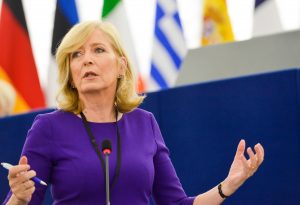
Photo: European Parliament (via EUObserver.com)
Today European Ombudsman O’Reilly presented the outcomes of her own-initiative inquiry of the transparency of Council preparatory bodies in the negotiation of EU legislative acts. Significantly, the Ombudsman found instances of maladministration, which signifies the strongest sanction her office can provide.
The European Ombudsman’s concludes her inquiry with the observation that the current way in which the legislative procedure in the Council is set out, it is impossible for citizens to have timely access to sufficient information on the general development of legislative dossiers and specific inputs offered by the different member states. The Ombudsman concludes that:
“[T]he Council of the EU – through practices that inhibit the scrutiny of draft EU legislation – undermines citizens’ right to hold their elected representatives to account. This constitutes maladministration.”
The Ombudsman’s team conducted a detailed inspection and analysis of a number of individual legislative procedures. Among the most important findings deriving from this inquiry are the observations that the Council Secretariat may not proactively disclose documents containing member state positions while legislative decision making is ongoing, that there were inconsistencies in the different working parties’ working methods with regard to documentation, that the Council’s public register is incomplete and “not very user-friendly”, and that the Council wrongly applies a certain automatism in labelling documents ingoing procedures “LIMITE”, which means that they cannot be made directly available to the public.
In response to these shortcomings, the inquiry report offers various recommendations. Most important among these are that the Council update its rules of procedure to reflect standards of good administration, draw up guidelines containing minimum standards for a document trail pertaining to legislative procedures, take steps to reduce the reliance on LIMITE documents to an absolute minimum, and more generally, provide more generous and earlier access to legislative documents.
Transparency gaps “feeds negative sentiment”
In her explanation to the findings, O’Reilly drew a link between the current transparency gaps in Council legislative decision making, and the populist anti-European sentiment that has been rising across the EU over the past years. The EU Observer quotes her stating:
“It’s almost impossible for citizens to follow the legislative discussions in the council between national government representatives. This ‘behind-closed-doors’ approach risks alienating citizens and feeding negative sentiment.”
She points out that steps taken ahead of the 2019 European Parliament elections would give off a “positive signal”.
The European Ombudsman’s findings were today positively received among civil society actors. Professor Alberto Alemanno, EU legal expert based at NYU and activist with “The Good Lobby”, spoke of “a historic decision” on the lack of transparency of the Council, while Olivier Hoedeman of the Corporate Europe Observatory remarked that “O’Reilly slams EU member state governments for secrecy and lack of accountability in Council decision-making”. The Parliamentary Greens group responded with a meme stating that “democratic decisions can’t be taken in the dark”.
The European Ombudsman has conveyed her findings to the Council of the EU, calling for a detailed response by 9 May at the latest, without request for delay “[g]iven the importance of this issue to EU citizens”.
Details regarding the own-initiative inquiry
The European Ombudsman’s own-initiative inquiry (case OI/2/2017/TE) was opened on 10 March 2017. It began with a written survey to the Council. On 5 October 2017, a public consultation was opened, to which 22 individuals and organisations responded, among them researchers, national parliamentary chambers and political parties. On 23 January 2018, a physical inspection of documents was conducted by a team of the European Ombudsman on the premises of the Council. On 13 February, the European Ombudsman presented her findings and recommendations. The Council is invited to respond to these by 9 May 2018 at the latest.
The European Ombudsman’s recommendations can be accessed here. An accompanying press statement is available here.
